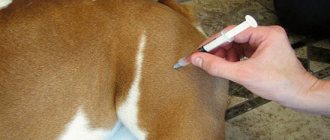What is pain and why is it important to relieve your animal's pain?
Pain is an unpleasant sensory or emotional experience associated with actual or potential injury.
Pain can be acute or chronic.
If the pain is severe, you can almost always eliminate the cause and thus relieve your dog of pain. Acute pain must be relieved within the first 12 to 24 hours.
If the pain is chronic, it is about maintaining an acceptable quality of life for the dog, because chronic pain reduces the quality of life. Various treatment methods are used here, both medicinal and non-medicinal.
Why is it important to relieve dogs from pain?
The fact is that, in addition to the negative impact of the disease on the dog’s body, pain aggravates the animal’s condition.
Due to severe pain, the dog cannot breathe normally (breathing becomes frequent and shallow), the resulting tachycardia can negatively affect the functioning of the heart muscle, weakened immunity (due to the accumulation of hormones in the body that negatively affect it) makes the body vulnerable to infections, increased blood viscosity increases the risk of blood clots, decreased peristalsis causes nausea and vomiting, etc. All this can lead to serious complications.
Of course, first of all, this all concerns very severe or prolonged and debilitating pain.
That is, pain is not just some “inconvenience”. Pain causes major physiological changes that will cause your dog to recover much more slowly (if at all). And proper pain relief at the acute stage prevents the development of a syndrome called “chronic pain.”
Breath
Panting, or panting with the tongue hanging out, is a way for dogs to cool down in the heat, but panting or panting can be life-threatening for the animal. Shortness of breath can be caused by inflammation in the nose, throat or lungs. Your dog may not be getting enough oxygen. Difficulty breathing is also a symptom of heart disease, which can be fatal. Fortunately, the disease can be treated if detected early enough.
On Christmas Heaven will open three times: when you need to make wishes so that they come true
“I’ve been using it for 11 years”: bloggers commented on Asmus’ New Year’s gift
Is nature joking? Cotton candy grows on trees
How can you tell if your dog is in pain?
There are signs that will help you understand that your dog is in pain:
- Rapid breathing.
- Cardiopalmus.
- Anxiety.
- The dog cannot sleep or wakes up constantly.
- The dog eats poorly or refuses to eat.
- Difficulty changing position (for example, difficulty getting up or lying down).
- Lameness, reluctance to move.
- Lethargy.
- Apathy.
- The dog takes a strange position (for example, hunched over).
- Changes in your dog's behavior, even minor ones (such as irritability or sadness).
All this is a reason to be wary. And if you notice one or more of these signs in your dog, contact your veterinarian as soon as possible!
Photo: pixabay.com
Pay attention to your pet's ears
Surprises await Taurus: what will the zodiacs be lucky in 2021, Lenormand cards told
Ruins of an ancient 2500-year-old temple of Aphrodite found in Turkey
Delicious cupcake with persimmons and nuts: preparing baked goods with seasonal fruits
A dog's ears may droop if he is feeling unwell or if his ears are infected. Dogs can develop three types of ear infections: external, middle and internal. Symptoms of outer ear problems—drooping ears, redness, discharge, and foul odor—require a trip to the vet. If external infections are left untreated, they can spread into the middle and inner ear, which can lead to hearing loss.
Myths about pain in dogs
Unfortunately, there are popular myths among a significant portion of dog lovers about whether and how dogs experience pain. These myths have long been refuted by science, but, like all unscientific beliefs, they are extremely tenacious. What kind of myths are these?
- This breed (pit bull, rottweiler, ... - fill in what you need) has a low pain threshold
. The pain breed as such does not exist in principle. There is an antinociception system. Antinociception is the body's mechanisms that allow itself to anesthetize itself, and without these mechanisms any pain would cause a serious condition. This system is indeed developed differently in different representatives within the same species and differs even during the life of one individual. For example, it may be developed differently in two people, but on average in children it is better than in older people. And there are dogs that, for a short period of time, when some serious stress factor is present, will not experience significant pain. But after this stressor is over (for example, after a fight), the dog will have a significant pain syndrome, and they need pain relief just like everyone else. - Nothing hurts in dogs
. However, dogs have even more nerve endings in some areas of their bodies than humans. Accordingly, with injuries to these areas (for example, the muzzle), the dog experiences more severe pain than, for example, a person with facial injuries. - The dog will be patient, it’s just a dog
. People who adhere to this point of view are better off not approaching animals at all. - The leg will heal better if the dog does not step on it
- which means that painkillers are not needed so that the dog can take care of the leg itself. This is often said after fractures. But, for example, veterinarian Tatyana Krasnova, speaking at the Pet's Behavior-2018 conference, cited research results that say that after surgery (osteosynthesis), functions should be preserved in full immediately after surgery (albeit with the use of painkillers). That is, the dog can fully move. And if the veterinarian says that the dog should not step on its foot, did he operate on it correctly? After all, in the case when a dog does not step on its foot, it will develop a contracture and will need a series of physical procedures to develop the foot later.
Pain relief
For many years, veterinary medicine largely ignored pain, largely because there were no safe or effective treatments. But today there are ways to relieve pain or alleviate its causes.
Commonly used medications include:
- Carprofen (Rimadyl, Rovera, etc.), a non-steroidal anti-inflammatory drug, commonly called an NSAID. It has both analgesic and anti-inflammatory effects, suppressing the synthesis of prostaglandins. The drug is used primarily for musculoskeletal pain such as arthritis and acute pain resulting from surgery or injury.
- Gabapentin, which is used as an anticonvulsant, sedative, sedative, and for the treatment of chronic pain syndromes. It is sometimes effective for pain that does not respond to NSAIDs or opiates.
- Buffer aspirin is a drug still widely used in the population. Aspirin is both an anti-inflammatory and analgesic, but is not as specific for some forms of chronic arthritis pain as some newer drugs. The main side effects are gastrointestinal and should not be given concomitantly with corticosteroids. Before giving your dog any medication, consult your veterinarian.
Other treatments for chronic pain are being studied, but we need more robust research into these alternative treatments. These include:
- Adequan (a polysulfated glycosaminoglycan) has been used in dogs with degenerative joint disease. It protects joints, helps regulate collagen synthesis, and may help reduce inflammatory mediators commonly found in arthritic joints.
- Acupuncture, which involves placing very fine needles on acupuncture points on nerve endings, results in an inhibitory blockade of neurotransmitters responsible for pain. Many people use acupuncture to relieve pain.
- Another alternative is cold laser therapy. It uses both visible and infrared light sources to improve circulation in the smallest blood vessels and relieve chronic musculoskeletal disorders.
- Diet is perhaps the most rarely used method of pain relief. Ketogenic and hypoallergenic diets have been used to treat inflammatory diseases and arthritis in humans and may have potential for dogs.
Along with a sensible diet and gentle exercise, your veterinarian can help create a program to reduce chronic pain. Making your dog feel comfortable will improve his quality of life and increase his enjoyment of time together. They depend on us.
How to relieve your dog's pain at home?
Unfortunately, at home, it is extremely difficult to relieve a dog’s pain (without harming it). However, it is possible to alleviate your pet’s condition to some extent.
- Apply ice to the injured area or massage with ice cubes. It is better to use frozen chlorhexidine rather than tap water.
- Consult with your veterinarian by phone whether you can use a painkiller and which one.
And be sure to urgently take your pet to the veterinary clinic
to have it examined by a specialist!
Photo: macdill.af.mil
There are diseases that cannot be cured (or relieve the dog’s pain) at home on your own.
Your dog has gained weight suddenly
By drinking water correctly, you can lose 8-12 kg in a month
Miracles happen at Christmas: Bishop Panteleimon told this story
The strained relationship between Cruise and Pitt: because of Jolie or the film “Interview with the Vampire”
If your dog does not have a defined area between the chest and hips, called a “waist,” then this is likely a sign that the dog is overweight. The Association for Pet Obesity Prevention estimates that 54 percent of dogs in the United States are overweight, which puts them at risk of cancer, diabetes and kidney inflammation just like humans. This can reduce the animal's life expectancy by 2-3 years. All dog owners should know about obesity.
How can an owner harm a dog?
If you treat a dog yourself, you can, unwittingly, seriously harm your pet. The main mistakes owners make when trying to relieve their dog’s pain on their own:
- Give “human” medicines. Many medications that help people are deadly for dogs!
- Give drugs that the veterinarian prescribed in earlier stages of the disease or for other diseases when new symptoms appear.
- Do not seek help from a veterinarian when your dog is in pain.
Monitor your dogs closely. If something in their behavior or appearance alarms you, it is better to play it safe and contact a veterinarian.
And let your pets be healthy!
Involuntary urination, traces of blood in urine or stool
The “Inspiration” cake can be made every day. They'll still eat you to pieces
I’ll make a layered salad “Vitaminka” for Christmas: it will decorate both the table and the holiday
Grinding stone found, made 150,000 years before the emergence of Homo sapiens
Such symptoms are signs of kidney failure, diabetes and liver disease. For example, if your pet is dehydrated, his kidneys may not be able to function properly, so he will urinate more often.











